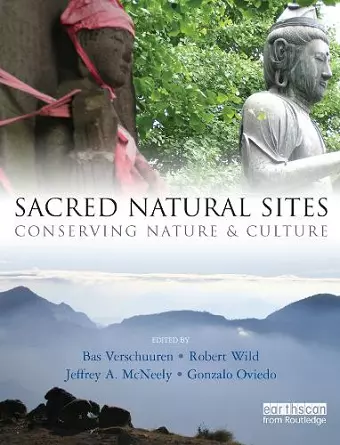Sacred Natural Sites
Conserving Nature and Culture
Gonzalo Oviedo editor Robert Wild editor Jeffrey Mcneely editor Bas Verschuuren editor
Format:Hardback
Publisher:Taylor & Francis Ltd
Published:5th Oct '10
Currently unavailable, and unfortunately no date known when it will be back
This hardback is available in another edition too:
- Paperback£56.99(9781849711678)

Sacred Natural Sites are the world's oldest protected places. This book focuses on a wide spread of both iconic and lesser known examples such as sacred groves of the Western Ghats (India), Sagarmatha /Chomolongma (Mt Everest, Nepal, Tibet - and China), the Golden Mountains of Altai (Russia), Holy Island of Lindisfarne (UK) and the sacred lakes of the Niger Delta (Nigeria).
The book illustrates that sacred natural sites, although often under threat, exist within and outside formally recognised protected areas, heritage sites. Sacred natural sites may well be some of the last strongholds for building resilient networks of connected landscapes. They also form important nodes for maintaining a dynamic socio-cultural fabric in the face of global change. The diverse authors bridge the gap between approaches to the conservation of cultural and biological diversity by taking into account cultural and spiritual values together with the socio-economic interests of the custodian communities and other relevant stakeholders.
"This book is being published in the International Year of Biodiversity, which gives it special importance as an expression of the special relationship between people and the rest of nature. It offers us an opportunity to remind ourselves of the deep and meaningful relationships that many religions and faith communities have with nature, demonstrated by their devotion to sacred natural sites such as those described in these pages." – Julia Marton-Lefèvre, Director General, International Union for Conservation of Nature, Gland, Switzerland
'If science is to serve life on this planet, we need more than just intellectual rigour, we also need ethical vigour. That demands values. But what might inform these? One basis is that which human experience has termed 'the sacred'. For some, 'the sacred' is a hypothetical concept. For others, it is a function of empirical experience in consciousness. Either way, this milestone of a book shows that the impact on nature conservation can be hugely positive, inviting scholarly critique and appreciation.' – Professor Alastair McIntosh, Centre for Human Ecology, University of Strathclyde, UK and author of Soil and Soul
"Sacred Natural Sites sports an international all-star cast and concise, no-nonsense chapters. The study of sacred natural areas has come of age, and this is the book to prove it." – Fikret Berkes, Distinguished Professor and Canada Research Chair at the University of Manitoba, and the author of Sacred Ecology
"This excellent book is a welcome addition to the academic and professional literature in the relationship between people and nature. The book is a must for all managers of heritage places where sacred natural sites occur, academics, heritage professionals, and students, not just of sacred natural sites but for those also from the culture side. It also ought to be brought to the attention of those preparing World Heritage nominations and to government agencies where the less famous examples exist outside formally protected areas and heritage sites." – Ken Taylor, IJHS Australia.
"...the volume works very well in providing appropriately-edited ‘signposts’ of issues and actions relevant to the intersection of nature and culture from across the globe, enabling practitioners to situate their own work in a wider context. It also meets the editors’ aims to provide a basis for future practical advocacy and action, raising both the profile of sacred natural sites as well as underlining the broader need to consider natural and cultural values in conservation activity."– Marcus Barber, Australasian Journal of Environmental Management
"Is scientific knowledge in conflict with religious sentiment? This book answers the question through the various case studies cited from Africa, the Indian subcontinent, South America, Russia, China and the United Kingdom, [and] shows that knowledge enhances understanding, and deepens sentiment regarding nature." – Manjusha Misra, School of Planning and Architecture, Bhopal, International Journal of Environmental Studies.
"This excellent book is a welcome addition to the academic and professional literature in the relationship between people and nature. The book is a must for all managers of heritage places where sacred natural sites occur, academics, heritage professionals, and students, not just of sacred natural sites but for those also from the culture side. It also ought to be brought to the attention of those preparing World Heritage nominations and to government agencies where the less famous examples exist outside formally protected areas and heritage sites." – Ken Taylor, IJHS Australia.
"It is an interesting book to have on your shelf, providing an excellent reference text for students, academics, and other individuals interested in natural sacred places. I would hope that it might also appear on the desks of legislators—or that it might at least be summarized by their staff in their briefs, to highlight the importance and vulnerability of these amazing places."- Kathy Velander, Mountain Research and Development
"In introducing the reader to the diverse world of sacred natural sites and exploring their potential for conservation planning and management, this is a publication that should be on the bookshelf of any scholar working on conservation related issues, irrespective of their disciplinary grounding." - James P. Robson, Human Ecology
"The book is a must for all managers of heritage places where sacred natural sites occur, academics, heritage professionals, and students, not just of sacred natural sites but for those also from the culture side. It also ought to be brought to the attention of those preparing World Heritage nominations and to government agencies where the less famous examples exist outside formally protected areas and heritage sites." - Emeritus Professor Ken Taylor, National Environmental Law Review
ISBN: 9781849711661
Dimensions: unknown
Weight: 1088g
336 pages